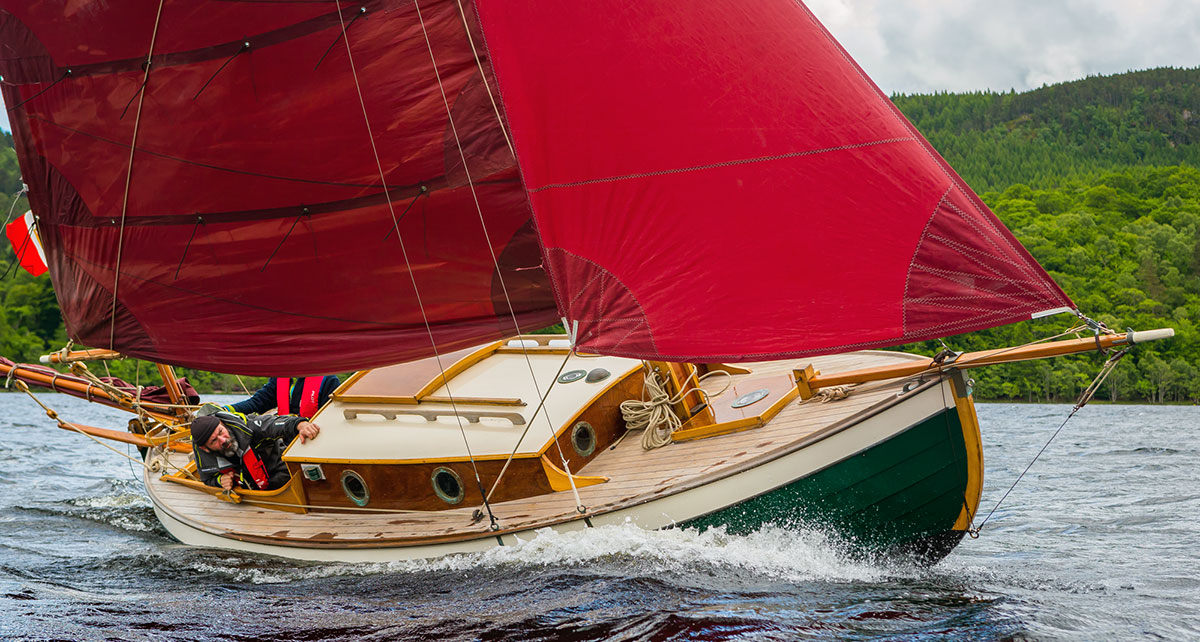Redmond Elver
This is a canoe yawl - a type of cruising boat popularized in the Victorian era as a way for adventurous sailors to get out on the water on a limited budget. Some amazing voyages were made in canoe yawls including those described in The Voyage Alone in the Yawl Rob Roy
 | |
| Steve Redmond's Elver |
Elver is 20 feet long and weighs under 1000 lbs empty. She is however a bit small inside to satisfy the requirements for easy sitting headroom and a separate berth for a guest. She has no ballast either, which makes her more susceptible to remaining upside down and ending up that way in a knockdown.
 |
| An Australian Elver |
A major step up from Elver is Oughtread's Eun Mara. A lovely little lapstrake sailboat, she would meet all the requirements except for ease of building and having 2 separate sleeping areas.
 |
| Ian Oughtred's Eun Mara |
 |
| Takatani - a wonderful example of this design |
I found a build blog for this boat and the estimated hours and elapsed years put me off building her.
The runner up for my favorite design is by South African Dudey Dix, specifically his Cape Henry 21, which is constructed in plywood laps but is less complex than Eun Mara.
 |
| Cape Henry 21 |
The Cape Henry 21 is an extended version of a popular 19 foot fiberglass design by the same designer. She has a sensible layout, a lovely appearance and good performance. The main issue I have with her is her very low freeboard and headroom in the cabin as you can see in the following plan snapshots.
 |
| Cape Henry 21 Plan view and side view |
The boat design I most like is by a New Zealander names John Welsford. I first heard of him this summer during a cruise to Jedediah Island where I met up with a few other sailors. One of these sailors was sailing a diminutive but seaworthy little 11 footer called a Scamp. This is Welsford's most famous design and it impressed me in how well thought out it was both in terms of easy construction and also seaworthiness. It also sails amazingly well for such a short tubby boat and could go to windward in 30 knots according to its owner.
The Welsford design I chose is his Penguin, a 21 foot trailerable plywood lapstrake design. She is the largest boat I looked at in terms of interior room and while the construction is not simple, it seems to be very well thought out. She ticks most of the boxes.

 |
| Penguin's gaff rig sail plan |
 |
| Clearly she is trailerable |
I ordered Penguin's study plans and mentally went through what it would take to build her. However as I am afraid many people do, I began to see a few things I would like to change in her. I didn't like the slightly short cockpit and the very high cabin sides. I wished she was a little longer to take advantage of 3 full eight foot sheets of plywood. I also wished she was a little simpler to construct - maybe just 3 chines rather than 5 planks and maybe stitch and glue construction rather than lapstrake ply. You can see where this is going? I decided to design a boat sort of similar to Penguin, borrowing many ideas from her including her excellent layout and overall concept but changing the construction method, and modifying her shape, lengthening her and putting on the higher aspect 2 foresail rig that the Cape Henry has. I will talk more about this in the next post...


No comments:
Post a Comment